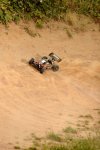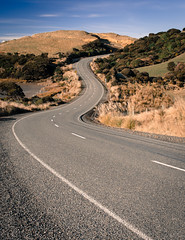Nitro R/Cs
What is small, fast and stinks like hell? Right, nitro powered R/C cars. These little bastards are fast, dirty and 100% pure fun, except that there is the tendency of modding and repairing them 75% of the time instead of actually racing around, even on location and in a group with others. Last week I twice had the chance to meet with a group of ongoing R/C car junkies. The just bought their gear so there was nothing special or self constructed to see yet but that on the other hand gave me the chance to experience and share the same novice perspective on the topic -> “WTF is wrong with this car. Breaks? Maybe pull the starter a little faster? Maybe its the Ignition? Ups… no fuel!”. One can get a full starters kit for about 150 EUR with a fully assembled R/C car, the actual remote control and a few replacement parts, nitro excluded. There is one thing i do miss though and that is my beloved green and red turtle shells… you can’t have everything. The starters set almost got me hooked but reflecting on it I luckily came to the conclusion that I have more than enough expensive hobbies and money sinks.
R/C cars are a great way to test you cameras auto focus. To paraphrase Ken Rockwell, the D7000 3D continuous AF grabs on to your target like a pit bull and doesn’t let go until you say so. Combined with the amazingly fast AF capabilities of the Nikkor 70-200 2.8 VR2 the cars had no chance of escaping. I’m still stunned by the amazing performance of this body lens combination, the out of focus miss ratio was only about 10% of the shots even though the cars were constantly moving back and fort, from left to right and i have little “sports” shooting experience what so ever. The shots on the off road track were taken using a Hoya ND 8x neutral density filter, the body glas combination mentioned above, a SB-900 with a 24′ softbox and two bare SB-28s all triggered using my modified Cactus V2s. The ND filter was used to push down the ambient light which was bright sun from time to time due to partially cloudy weather.
Now why do you want to take away light you might ask? First of all shooting in bright daylight forces you to stop down to maybe f/5.6 ISO 100 or worse to stay within your strobes speed limits… bye-bye shallow depth of field. Second the strobes wireless triggers also can’t shoot any faster than 1/250th of a second which is the fastest sync speed you can reach using a Cactus V2s and most other wireless triggering systems. Yes you are right, i wrote 1/200th of a second in the Fontainebleau post, but that they can reach a 1/250th with fresh batteries, my mistake. Shooting faster than 1/250th your shutter curtain will crawl into the frame. By using the ND you make your glass worse w.r.t. speed but without affecting the DOF. This will put more pressure on the strobes as they are affected by the ND as well and have to compensate for it by emitting more light. On the other hand you can shoot a 1/250th f/2.8 without the ambient burning into your picture and still use strobes. Using a high-speed sync system like Nikon’s CLS can help here as well.
Having read this months “CT Special Digital Photography” (german version, the english translation is not yet available) article on sharpening I had to try RawTherapee‘s RL deconvolution sharpening implementation. There are a lot of open source raw converters and tools but I think RawTherapee is by far the best converter when it comes to a productive and time effectiveness in the workflow. If you haven’t tested it yet you should definitely give it a try, you won’t be disappointed. The RL deconvolution uses an imaging systems so-called point spread function (PSF) to iteratively calculate a the “original” image.
The basic idea is as follows: If a perfectly 1 pixel sized beam of light hit my camera sensor after being transmitted by the glas it would most likely still blur due to the systems inherent imperfections. Even if we do not know how exactly this perfectly small beam of light is blurred we can estimate the blur which most likely is some kind of radial pattern. This pattern is the PSF. With this estimation of the blurring we iteratively calculate the “original” image for every pixel of the picture. The RawTherapee implementation took much more time on my system than the USM but for single images or large-scale printing purposes i see some clear advantages over USM. The following image was processed from raw and scaled to 200% without interpolation. You need to view it as a 100% image in your browser to see all details and differences.


















